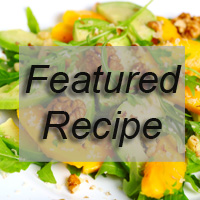Creamy Salmon Sauce/Dressing/Dip
Makes 2 cups
(No gluten, dairy, cane sugar, egg; with options for nightshades and soy)
Thick, creamy and flavourful, you can make this in 10 minutes and employ it in a multitude of creative ways. Although the sauce warms up well just tossed with the likes of hot pasta or veg, if preferred first warm it gently over very low heat (don’t let it bubble). The jalapeno peppers contribute a tangy, mild oomph. ‘Hot’ foods like this have also shown the ability to minimise pain and to thwart pathogenic invaders (see my HEALTH STORE report: How To Thwart Fungal, Yeast, Viral, Bacterial and Parasitic Invaders – and Build Strong Immunity).
The salmon and tofu both provide lots of protein and minerals, especially calcium and magnesium in a balanced and absorbable form. Taking too many calcium supplements without sufficient magnesium promotes bones that grow but with brittleness; blood vessels and muscles that can contract but not relax fully. Excessive intake of any one mineral or vitamin is as injurious to health as eating too much good food. The act of swallowing makes substances disappear from view, but not from the laws of action and consequence. Claims, for example, that such excesses are just urinated out are viewpoints without respect for the intricate feedback systems, and quantum relationships of your inner world.
150 g firm tofu*, roughly broken
***
210 g tin red salmon in natural juices*
3 Tbsp extra-virgin olive oil*
3 Tbsp white wine vinegar
2 spring onions, coarsely chopped
1 large clove garlic
1 Tbsp fresh oreganum, basil or lemon thyme
1 Tbsp chopped pickled jalapeno or other hot peppers*
1 tsp sea salt with kelp*
***
1/2 small red pepper or 3 diced radishes, finely chopped
Place the tofu in a food processor and process finely. Add the remaining ingredients, including the salmon juices – but not the red pepper or radish. Process on high until well pureed. Stir in the pepper or radish for some contrasting colour and crunch. Use as indicated or cover and chill for up to one week.
Serving Variations:
• Serve as a topping over baked potatoes, kumara or pumpkin; sprinkle with chives. Accompany with salad or mixed steamed courgette, parsnip, and Brussels sprouts.
• Serve over a summer salad of greens with: strawberries, asparagus and diced gherkins; or nectarine, melon or any firm fruit, mushroom and red onion; or courgette, olives and figs. Serve with rice, bread, corn on the cob, or steamed baby potatoes.
• Serve draped over a platter of steamed baby carrots, cauliflower, broccoli and green beans. Sprinkle with fresh parsley. Surround with tinned baby beetroot and pickled mushrooms.
• Toss with cooked pasta, toasted pistachios, fresh basil, more chopped red pepper and sliced mushrooms. Serve with mixed steamed greens.
• Toss with chickpeas, black olives, cherry tomatoes or orange segments, and chopped spinach. Serve with baked pumpkin, kumara or hot pita bread (Spoilt For Choice brand from health stores is free of dairy, gluten, cane sugar, soy, egg, nightshades).
• Combine half the mixture with a similar amount of cooked rice, other grain, or breadcrumbs and use as a stuffing for hollowed tomatoes, peppers or red onions. Bake or fan grill 20-30 minutes at 180°C (350°F) until soft. Serve with an apple, celery and walnut salad.
• Keep on hand for easy lunches. Use as a sandwich filling/protein (with cucumber or pear, lettuce or sprouts, and mustard); or drape over sliced fresh vegetables and accompany with toast or crackers; or mix with leftover cooked veg, pasta, legumes or rice; or dollop into a mug of hot broth or miso soup.
• Serve as a dip – for entertaining or as a snack (this presentation style can successfully charm children into eating fish and veg). Sprinkle with chopped chives or parsley. Accompany with crackers, corn chips, pita wedges, sliced cucumber, mushroom and carrot.
Shopping and Preparation Tips*
• Fish-tinned: buy plain varieties. Most ‘seasoned’ fish (and snack foods) include sugar, wheat, dairy, and artificial additives (which are also usually based in dairy, wheat, potato or soy). Red salmon can not be farmed, so it is always wild and likely to be more nutritious (farmed fish can be fed artificial additives, colourings and other questionable ingredients).
• Olive Oil: extra virgin olive oil is achieved by using cold mechanical pressure rather than the high heat and chemical solvents typical to most supermarket oils. These practices damage oils and the people who eat them. For information on which fats to choose for which purpose and why, see my article on the TIPS page: The Fats of Life.
• Peppers: Old El Paso Jalapenos, or more intense, red Delmaine Hot Baby Peppers come pickled and sliced in jars. Find these in the olives’ and pickles’ section, or Mexican foods’ section of supermarkets. To exchange try a little wasabi, horseradish or hot English mustard to taste.
• Sea salt: is sea water dehydrated by sun. When mixed with seaweed (containing iodine and other minerals low in our soil) it is ideal in terms of flavour (interesting but not too strong) and mineral balance. Try Pacific Harvest or Malcolm Harker brands; both in health and gourmet stores. Ordinary salt is taken from mines or sea and so highly refined over extreme heat that it contains nothing but sodium chloride. All other minerals are stripped away, such as potassium and magnesium which help regulate fluid balance and blood pressure. Bleach as a whitener and chemicals to prevent clumping may be added to table salt.
• Tofu: Use firm tofu for most uses such as chopping or grating. It usually comes in a plastic wrapper in the chilled food section of the supermarket. Use the silken tofu for smoothies, miso soup or in many desserts. Silken tofu is very soft like custard and usually comes in a box. The tofu in this recipe can be exchanged for 2 large, soft or hard boiled eggs, plus 1/4 cup tahini. Process as per tofu.



